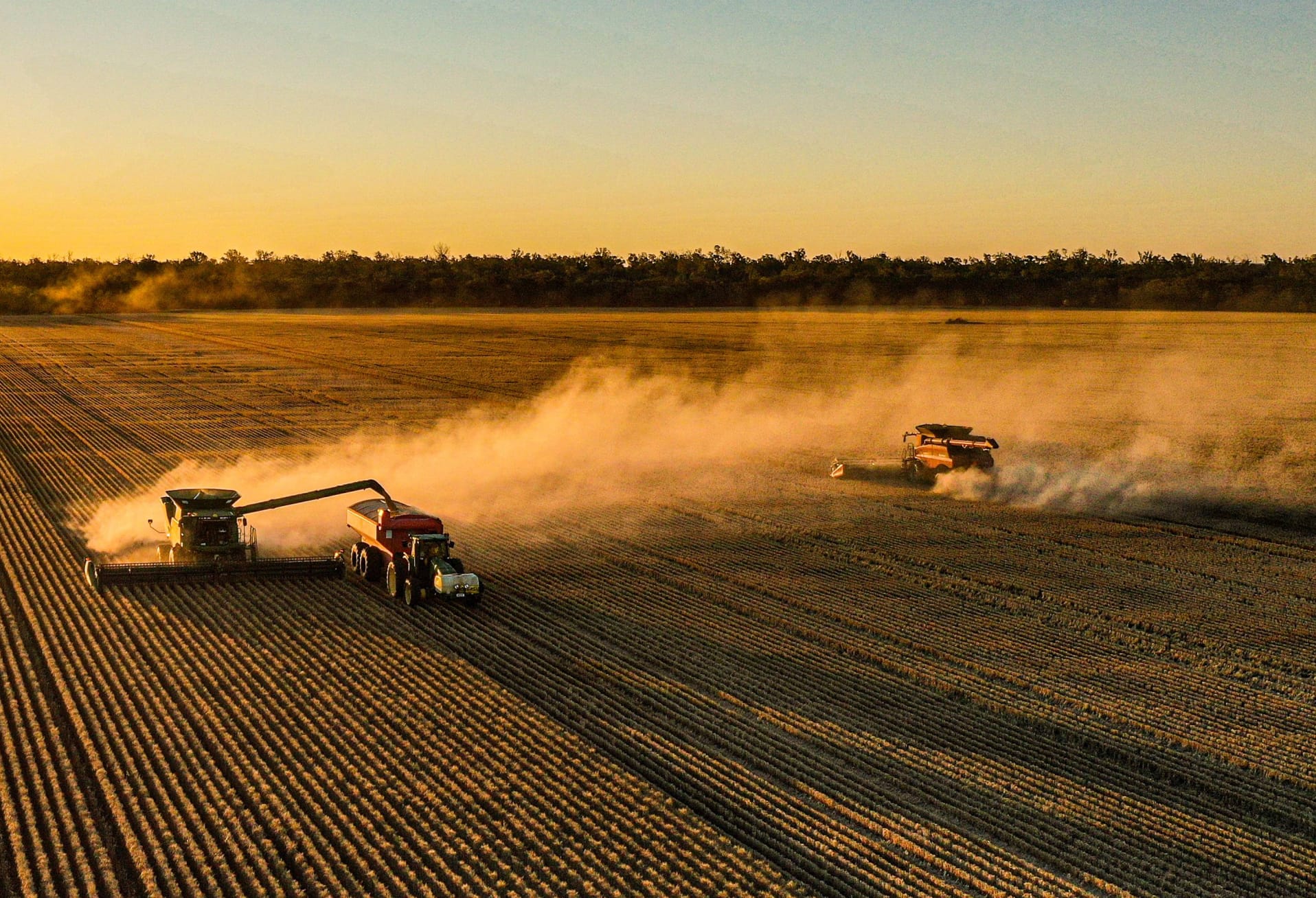Take home messages
- Compass, Fathom and Scope CL were good competitors with weeds, which is consistent with previous years’ findings.
- Hindmarsh and Spartacus CL are poor weed competitors.
- The advantage of sowing earlier in order to increase crop competition failed to improve the
competitiveness of La Trobe given the high spring rainfall.
Background
Barley varieties have different growth habits and vigour, which can affect their ability to compete with weeds during the season. Some varieties have an erect growth habit which allows more light into the canopy compared to a prostrate growth habit which shades out more of the crop row in between.
Previous research has shown, Hindmarsh to be a poorer competitor due to its slow early vigour and erect growth habit which allows more light into the canopy accessible for weed growth. There are now a number of high yielding varieties available that are very similar to Hindmarsh agronomically. Can the competition of these varieties be increased through different management strategies such as altering time of sowing (TOS) and nutrition?
Aims
- To compare the competitiveness of new and existing barley varieties in the presence and absence of weeds.
- To increase the competitiveness of a non-competitive variety through sowing time and nitrogen applications in the presence of weeds.
Paddock details

Trial details and inputs
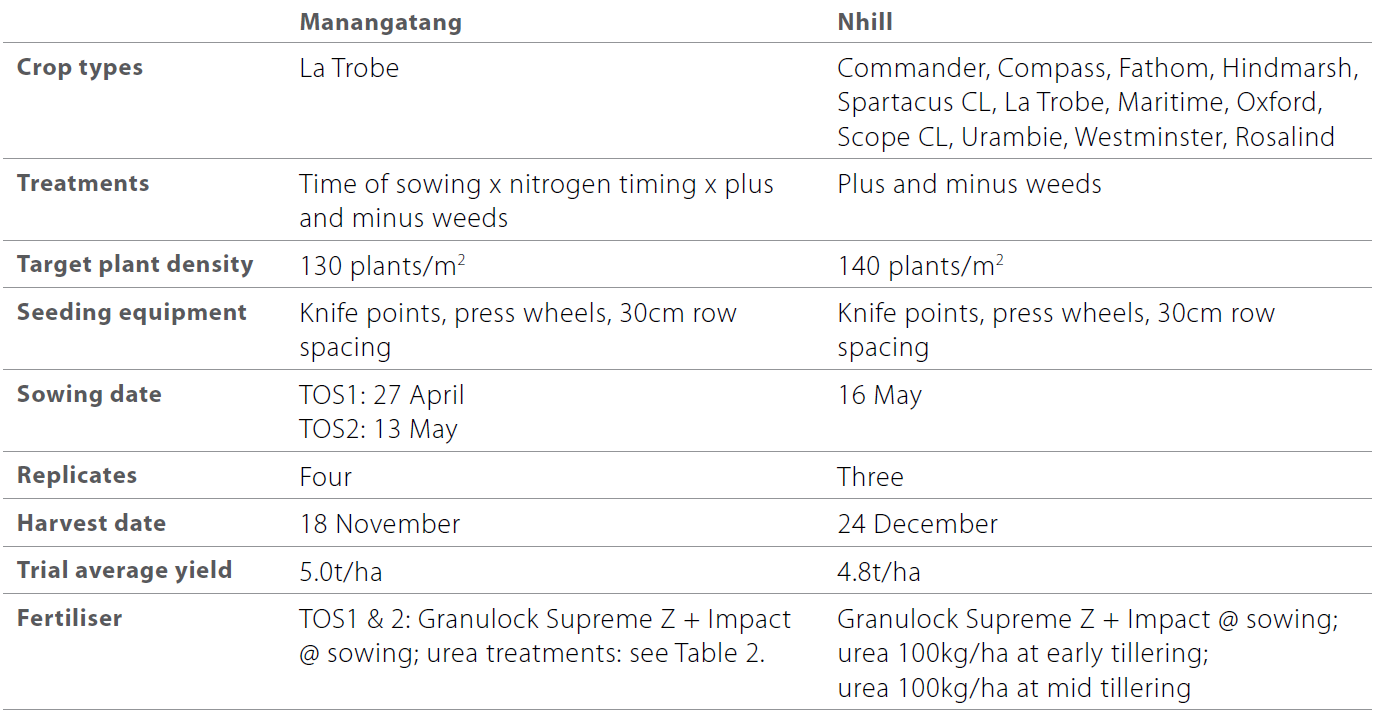
Pests, weeds and diseases were controlled to best management practice.
Method
Nhill
The trial at Nhill was established with 12 barley varieties with three replicates in a split plot design, including plus and minus weed plots. Matika oats were used to simulate a ‘grass weed’ sown at 75 plants/m2. The oats were broadcast prior to sowing and then incorporated into the soil with the seeder.
Assessments throughout the season included: establishment counts (barley and oats), NDVI at GS22 (early tillering) and GS32 (second node), maturity biomass cuts (barley and oats) and grain yield and quality parameters (on barley and oats).
To obtain a ‘true’ barley yield in the plus weeds plots, a 100g sub-sample was taken from each plot sample. The barley and oat grains were then physically separated and weighed to determine barley yield (with no oats present).
Table 1. Variety characteristics for early vigour, height rating, early growth habit, maturity and competitive ability.
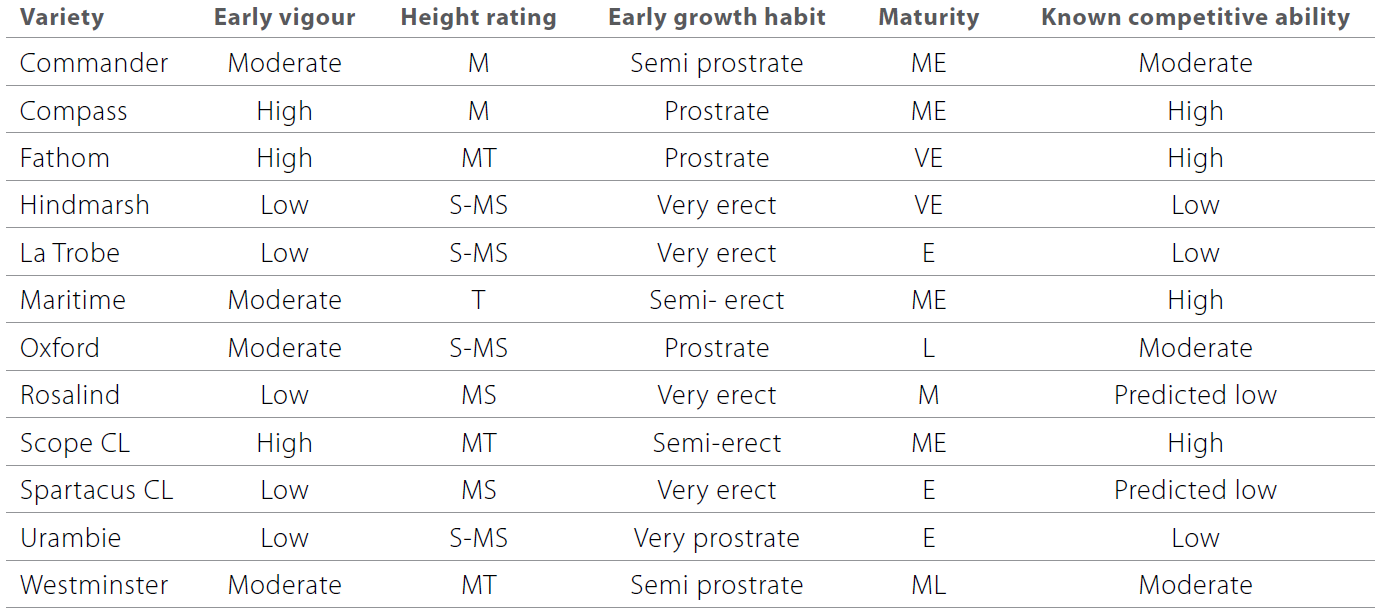
Maturity: E = Early, EM = Early-Mid, M = Mid, ML = Mid-Late, L = Late.
Manangatang
In addition to the weed competition trial at Nhill, further investigation was undertaken at Manangatang that looked at increasing competition of a non-competitive variety. The trial was a randomised block design with four replicates. La Trobe was chosen to represent a variety that has an erect growth habit and slower early vigour. This plant architecture and growth habit has been known to be non-competitive (in previous research) and can relate to agronomically similar varieties such as Hindmarsh, Spartacus CL and Rosalind.
To try and increase competition, TOS and nitrogen (N) application timing was varied and compared in the presence and absence of weeds. Two sowing times were used (early and later), plus and minus weeds and different nitrogen timings, however only one treatment in TOS1 was analysed for this report (Table 2).
Nitrogen rates attempted to follow farmer practice in the region and sowing dates were also suited for the northern Mallee. Matika oats were used to simulate a grass weed and were sown at 75 plants/m2. They were spread prior to sowing and then incorporated into the soil at sowing.
Table 2. Treatment list.

Results and Interpretation
Nhill
The barley trial at Nhill was quick to germinate, however the oats (weeds) were notably slow to establish and were fully emerged about two weeks after the barley. Establishment rates in the oats wasn’t as high as targeted (75 plants/m2), averaging 37 plants/m2. However, the site received above average rainfall during the season and adequate N ensuring the barley and oats were quite vigorous. The site was lower yielding than expected given the amount of urea applied and the starting soil N level.
Effect of ‘weeds’ on crop growth and yield
Barley yield was effected by the presence of weeds, even with a lower establishment of weeds (Table 3). The plus weeds treatment yield value has been calculated by taking any weed seed out to determine the reduction in yield.
NDVI was greater at early tillering in the presence of weeds, demonstrating that there is more green light to capture when weeds are present and the barley canopy is quite open. The biomass of the barley was also greater in the weed free plots, as plants had greater access to light, moisture and nutrition with no weeds present.
This trial again indicates the benefit of keeping crops weed free with a 0.6t/ha yield loss when barley is sown into weeds.
Table 3. The average performance of barley varieties with and without weeds (oats), measuring barley and weed establishment (weeds/m2), NDVI (GS21 and GS32), barley biomass at maturity (GS99) and barley grain yield (t/ha).

Was there a difference between varieties?
When looking at the interaction between varieties it is important to note the growth habit and canopy architecture of different barley varieties. Varieties such as Rosalind, Spartacus CL, La Trobe and Hindmarsh have a lower NDVI (at early tillering), due to their erect growth habit and slower early vigour (Figure 1). Due to this open canopy, more light is able to penetrate through, potentially favouring weed growth. By contrast, varieties such as Scope CL, Fathom, Commander and Compass have a more prostrate and vigorous early growth habit.
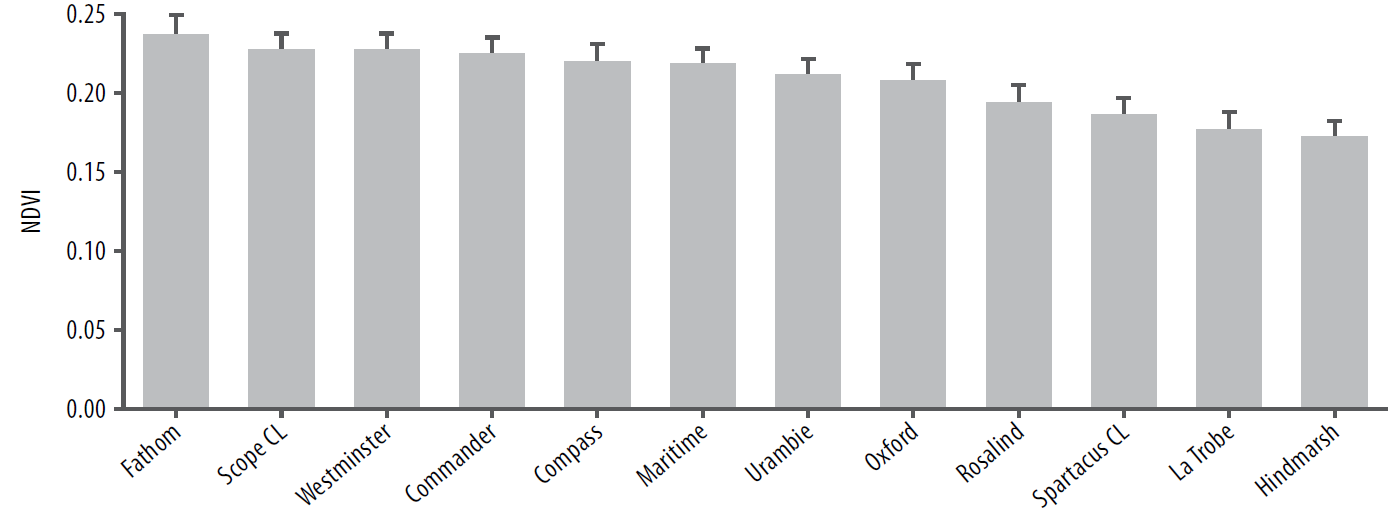
Figure 1. NDVI (at early tillering) of barley varieties in the absence of weeds, representing differences in growth habit and canopy architecture (P<0.001, LSD= 0.01, CV=3%).
Hindmarsh and Urambie stood out as being the worst competitors against weeds (Figure 2). Urambie’s later maturity and prostrate early growth habit means it is extremely slow in early vigour, growth and height. This is the perfect environment for weeds to thrive, especially early in the season.
Hindmarsh is renowned for its lack of competition due to its slow early vigour and erect growth habit allowing more light into the canopy, favouring weed growth. These varieties that have suffered the most yield loss in the presence of weeds, showing that they have a poor ability to suppress weeds setting seed. Spartacus CL was also another variety that had greater yield loss. It has a very similar architecture and growth habit to Hindmarsh.
Surprisingly, Rosalind and La Trobe, that are also agronomically similar to Hindmarsh, showed a slightly better competitive ability.
There was no difference between the amount of biomass produced by varieties at maturity.
Similar to BCG’s 2013 trial, varieties that offered good competition were Compass, Scope CL and Fathom. Compass performed extremely well incurring the least yield loss and having the greatest ability to suppress weeds to prevent them going through to seed set.
Figure 2 shows the percentage of yield loss when different varieties are under weed pressure versus the amount of biomass (t/ha) produced by the weeds. The weed biomass (t/ha) is directly related to weed yield (t/ha). Varieties that allowed the weeds to produce greater weed biomass, also had a greater weed yield in the plot.
Figure 2 demonstrates varieties that fit into:
- A section: Incur less yield loss, but have a poorer ability to prevent weeds setting seed.
- B section: Are the poorest competitors as they incur the greatest yield loss and also allow more weeds to set seed.
- C section: Have a high competitive ability, with less yield loss and less weed seed set.
- D section: Incur the greatest yield loss, but have a better ability to suppress weeds setting seed.
If there were greater weed numbers in the trial, it would be likely to see a greater spread between these categories.
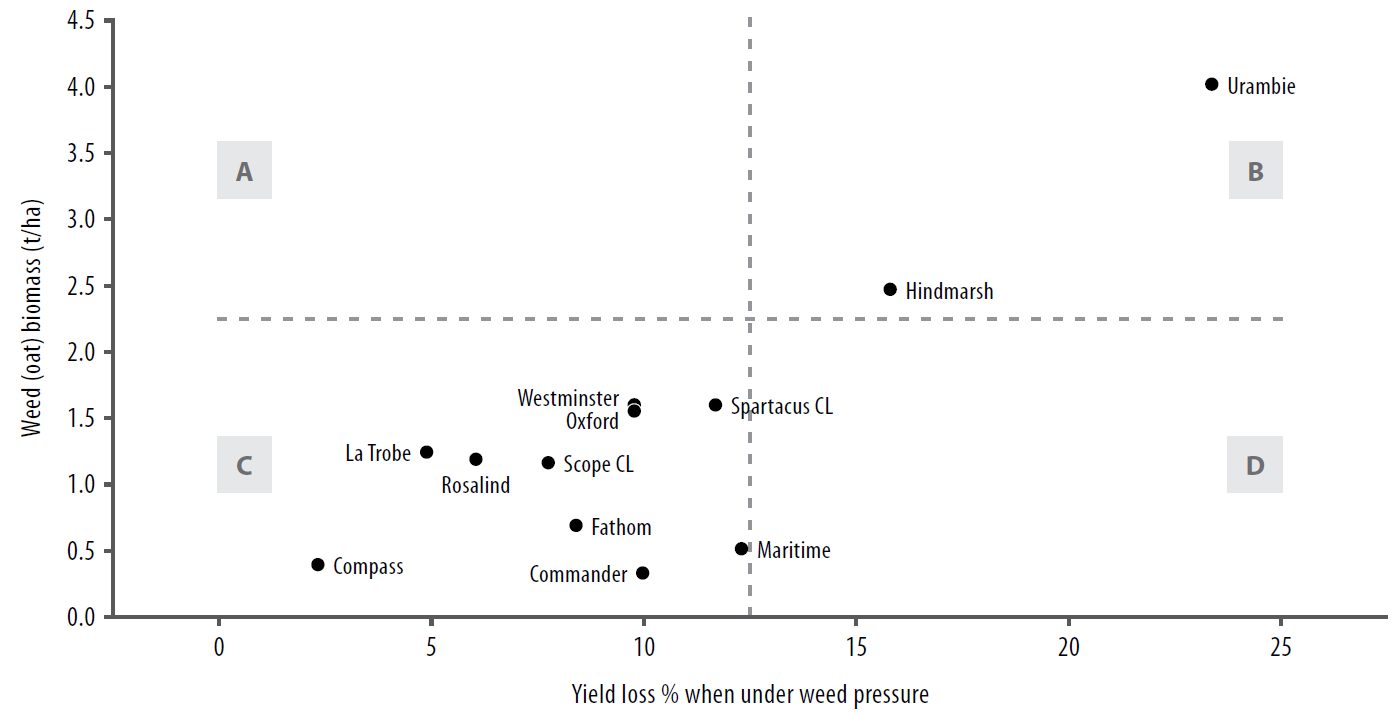
Figure 2. The per cent (%) of yield loss in barley varieties when under weed pressure compared to weed (oat) biomass (t/ha).
The growth habit of varieties was analysed but there were no significant differences between yield loss and growth habit. The interaction between yield loss and plant height was also analysed showing, in general, the shorter the variety the greater yield loss when trying to compete with weeds.
In terms of grain quality, there were no differences between varieties in the presence or absence of weeds. There were however, differences between varieties in protein, test weight, retention and screenings. Protein was quite low at the site; test weight was also low which would have been influenced by having oats (weeds) in the sample. Retention was high and screenings were low. No malt varieties actually made malt specifications, either due to low test weight or protein.
Manangatang
The trial at Manangatang had two different sowing times, however only one treatment was in TOS1 was analysed for this report. The trial emerged well in both sowing times. The barley and weeds (oats) in TOS1 were very vigorous, emerging quickly after sowing, however the weed emergence numbers were lower than anticipated averaging 41 plants/m2.
In TOS2, the weed (oat) emergence numbers were higher, averaging 72 plants/m2 but growth was slower, less vigorous and there was less accumulation of biomass.
Did nitrogen timing influence the competitive ability of La Trobe when sown later?
Altering N timing to increase the competitive ability of La Trobe had no effect on overall yield.
This may have been because the N rates used weren’t high enough to give a response and the site also may have had more N accessible further down the profile than tested (tested to 60cm).
There were differences in biomass (at maturity) in the urea treatments alone, but it didn’t translate through to yield. The predrilled treatment had the lowest biomass.
There was a difference in the tiller production between the N treatments. The pre-drilled urea treatment had fewer tillers in the weed free plots.
There were also no differences in grain yield between the plus and minus weeds treatments. This is mostly due to lack of vigour and biomass in weeds as they established late and the barley was much more vigorous early on, getting away from the weeds.
There were no differences in grain quality between any of the treatments. All treatments made malt grade.
Was La Trobe more competitive sown earlier or later?
Only one treatment was compared for both sowing times: La Trobe sown with weeds; with 25kg/ha of urea predrilled plus 25kg/ha top-dressed (mid tillering). The sowing times were separated by 16 days.
Weed numbers were lower in the first time of sowing (cause unknown), averaging 41 plants/m2, compared to the second time of sowing with 72 plants/m2 (Table 4). However, the weeds in TOS1 were extremely vigorous and competitive resulting in greater oat biomass and yield which led to a yield reduction in the barley.
A possible explanation is that the earlier sown barley had 15 days fewer to progress through its growth stages than its later sown counterpart. It potentially grew too quick due to warmer soil and environmental temperatures, resulting in less time to tiller and produce biomass.
The barley that was sown later produced more tillers and biomass, resulting in a more competitive plant. Consequently, there was a 1.2t/ha yield benefit from later sowing.
There were no differences in test weight, retention, protein and screenings between the early or later time of sowing. The second time of sowing made malt grade (based on all quality parameters), whereas the first time of sowing made feed grade due to test weight being slightly below specifications (64.67kg/hl).
Table 4. Barley and weed establishment numbers, tillers, barley biomass, weeds biomass and grain yield for barley sown on April 27 and May 13.

Commercial practice
With herbicide costs and resistance on the rise, integrated weed management (IWM) is becoming increasingly important. This investigation into a ‘cultural’ weed control strategy is just another piece in the puzzle and should be used as part of an integrated approach to weed control.
In the excellent 2016 growing season, using nitrogen timing to increase competition in La Trobe wasn’t beneficial, however, sowing La Trobe slightly later (in this season) produced more biomass and tillers, providing greater competition against grass weeds. It should be noted that it is difficult to gain as much from crop competition when moisture is not limiting as it can negate the effect.
In terms of the competitiveness of varieties, this research again confirms that Hindmarsh is a poor competitor against weeds. Spartacus CL, which is a new Clearfield variety that is agronomically similar to Hindmarsh, also showed a poorer ability to compete. Spartacus CL does have the benefit of being able to control weeds in-crop with Intervix®. However, over-reliance on this technology for more than two consecutive seasons alone is likely to fast-track resistance, especially when using poorly competing varieties in a weedy paddock.
In a plant back situation consider the long-term impact of growing a poorer competing variety and the likelihood of more weeds emerging in the subsequent season. Other weed management tools would need to be used in this case.
Varieties that have shown good competitiveness against weeds, which is in line with previous BCG and SARDI research, include Compass, Scope CL and Fathom.
Selecting a barley variety, however, is a decision that should be viewed as part of a long-term strategy, with an overarching aim to reduce seed bank levels and to maintain or improve the productivity of the paddock. It’s a matter of spreading risk by choosing a variety for specific reasons and tailoring it to the right paddock. If you do have problematic paddocks, growing two varieties such as Hindmarsh and Spartacus CL is potentially not the best option due to their lack of competition.
Choosing competitive varieties and managing them to be competitive will help reduce weed burdens and seedbanks more efficiently when used as part of an integrated approach to weed control.
On-farm profitability
The less competitive a variety is the greater the economic loss when weeds are present. This year, based on a feed price (due to downgrade from weed contamination), Hindmarsh yields suffered up to a 16 per cent penalty (Figure 2) when sown into a weedy paddock, resulting in $94t/ha loss (Table 5). Growing this variety year on year would also increase the weed burden due to the high carryover of weed seed.
By contrast, a competitive variety such as Compass only suffered a two per cent yield reduction ($10t/ha) in the presence of weeds.
This research highlights the importance of keeping your crops weed free. At Nhill, sowing barley into a weedy paddock resulted in a 0.6t/ha yield reduction (mean of varieties), equating to a $72t/ha loss (based on Nhill feed price).
Grain quality also suffers due to higher weed seed numbers in the grain sample.
Table 5. Income and yield penalties when weeds are present in a barley crop. The grain price used ($120.30) was based on a Feed 1 cash price from Nhill on 1 December 2016.
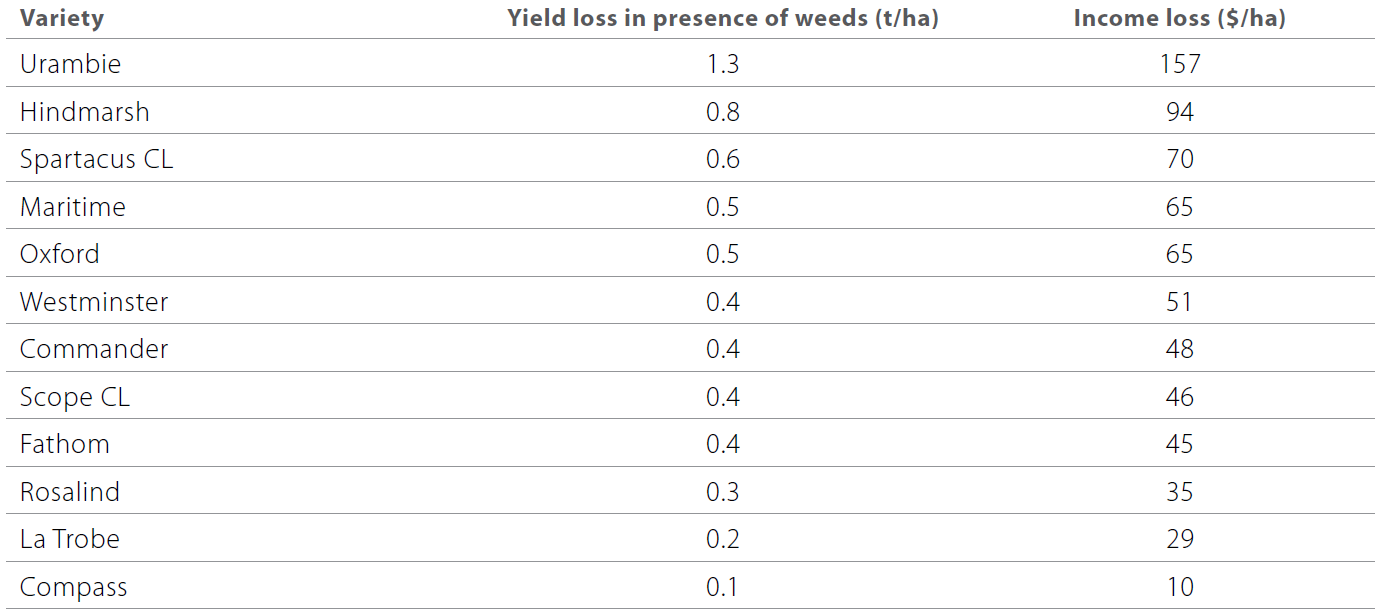
References
GRDC Victorian Winter crop summary 2016.
Acknowledgements
This research was funded by the GRDC as part of the Barley agronomy for the Southern Region project (DAN00173).
